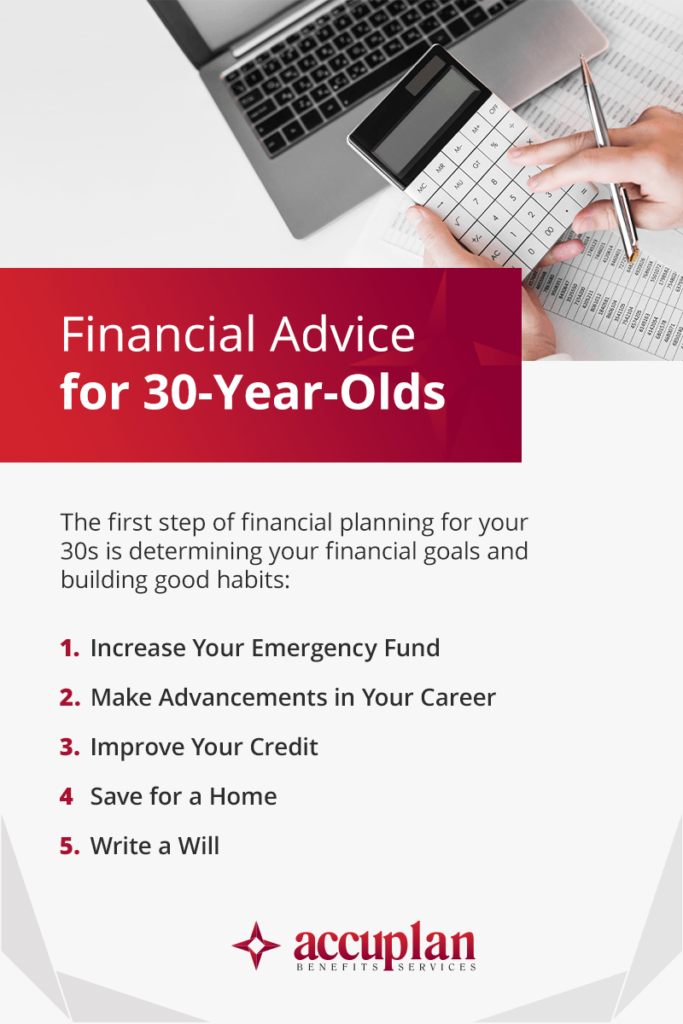
Many 20-somethings are graduating from college, entering the workforce for the first time and learning how to navigate the financial responsibilities of adult life. When it comes to building toward and meeting your financial goals, your 30s is a great time to get started.
If you will soon be entering your 30s, now is the time to consider best practices of finances in your 30s. These include setting financial goals for your 30s, how to start saving for retirement at 30, how to build your wealth, how to invest and the best investments you can make in this decade of your life.
Understanding Financial Goals in Your 30s
It’s crucial to have a clear understanding of your financial goals in your 30s, both in the short term and over the long haul. It starts with assessing where you currently stand and where you want to be in the future. You should recognize the importance of setting priorities for your money and creating a cushion for unplanned future expenses.
Whatever your goals are, ensure they are SMART:
- Specific: Specify how much you want to save and what you are saving it for.
- Measurable: Ensure you can track your goals’ progress toward your goals, like saying you want to save $500 toward your emergency fund.
- Achievable: Set goals that align with your current financial situation, considering your income, expenses and other obligations.
- Relevant: Align your goals with your life plans. If early retirement is a priority, ensure your budget focuses on these savings.
- Time-bound: Set deadlines for yourself. For example, you might aim to pay off your credit card debt within 24 months.
Financial Advice for 30-Year-Olds
The first step of financial planning for your 30s is determining your financial goals and building good habits, like managing your debts and saving consistently.

1. Increase Your Emergency Fund
In your 20s, you may have saved a small emergency fund. Now is the time to increase this fund. In your 30s, your income and expenses tend to increase, so your emergency fund should also increase. Aim to set aside three to six months of your living expenses that will act as a buffer for unexpected expenses or a loss of income.
You can use these funds to pay your bills if you face an unexpected job loss or a medical emergency. Move your emergency fund to a high-interest savings account to earn the most on your money. If you can get a raise, this can help you increase your emergency fund savings more quickly.
2. Make Advancements in Your Career
Your 20s are typically spent developing your marketable skills. You may have gotten a degree, entered a new field or considered a few different career paths. No matter your path, you’ve likely developed skills during this time that you can use to advance your career and increase your earnings. Research possible career paths you can take with your skills, and find the types of jobs you’re interested in.
If you are already working in your ideal field, consider how you can advance your career or get a promotion. This could involve searching for new opportunities, taking on new responsibilities, or relocating. Making big career moves now could pay off down the road.
3. Improve Your Credit
Check your credit and determine whether your score could be improved. You can request a free credit report from the major credit bureaus each year, and you may be able to monitor your credit score through your credit card provider or financial institution. Reviewing your credit report regularly lets you quickly identify and fix any errors or catch an identity thief.
Along with disputing errors on your credit report, you may be able to improve your credit score by ensuring you make each of your payments on time, pay off your credit card balance in full each month and maintain a variety of accounts, such as credit cards and loans.
4. Save for a Home
A home can be one of the best assets to buy in your 30s. In some markets, it can be more advantageous and even more affordable to buy a home rather than rent.
When you purchase a property, you begin building equity in your home as soon as you start making your monthly mortgage payments or when you put cash down on your home upfront. This may be a better financial move than losing money to rent each month with nothing to show for it at the end of your lease. To maximize the appreciation of your home, move to a neighborhood with high potential for growth.
To put yourself in the best possible financial position, you may want to first save up a down payment on your home. To avoid private mortgage insurance (PMI), you may want to save as much as 20% of your home’s value. For example, if the maximum you want to spend on a home is $200,000, the ideal down payment would be $40,000. Saving up for a down payment could take some time, so begin saving as soon as possible.
Keep in mind that you will also need to cover closing costs and may need savings for repairs or renovations, so you may want to save extra on top of your down payment.
5. Write a Will
Maybe it seems too early to worry about writing a will, but if you are married or have kids, be sure to write a will. Without a will, others can determine how your estate should be split. You may be able to complete your will yourself, or if your circumstances are more complicated, you may prefer to work with a lawyer who can draw up a will for you. When major life changes occur, remember to update your will accordingly.
Financial Planning in Your 30s
Create a roadmap for your money that balances your immediate needs with your future goals. Your 30s are a time during which you want to start building good credit and investing to grow your wealth.
Budgeting Tips
Start by listing all of your income and expenses, allocating money to essential categories like transportation, debt payments, groceries and housing. Use the 50/30/20 rule, which sets aside 50% of your income for needs, 30% for wants and 20% for your savings or debt repayment.
Stay within your budget by tracking your spending. You can use apps, spreadsheets or a journal to identify where your money is going and where you may be overspending. Automate your savings and investments, making this a non-negotiable expense in your budget.
Financial Goal Setting
Be specific with your goals. Clearly define what you want to accomplish, whether it’s paying off debt, building an emergency fund or planning for your retirement. The more specific you are, the easier it is to track your progress. Break your goals into short-term, medium-term and long-term objectives. Start by building a small emergency fund while you work toward growing a sizeable retirement fund.
Make them measurable by using numbers to track your progress. For example, if you have $3,000 in debt, set a monthly repayment target.
Building Wealth in Your 30s

When you set out to start building wealth in your 30s, start by laying a strong foundation for your long-term stability and success. This decade typically offers greater earning potential, so you can use that to start with the following:
- Create or adjust your budget: Your budget should include your income, expenses and goals, and you may need to make adjustments during big life changes, such as marriage or the birth of a child. For example, you may need to reduce your budget for eating out when you have a baby on the way.
- Take on risk: While you’re young, taking on risk can be beneficial in the long term. You still have time to overcome short-term volatility in the market, and the risk could lead to a greater average return. With compound interest, this means you can invest less money and still hit the same savings goal as someone who invests more into lower-risk investments.
- Get started now: Start investing as early as possible. Compound interest will work in your favor the earlier you start investing for your financial future, so start today.
How Can I Build Wealth in My 30s?
You should take a strategic approach to building wealth. Spend less than you earn, follow your budget, and diversify your income streams. Relying on a single paycheck can be limiting, but creating multiple sources of income can speed up your savings and increase your financial stability. You can take on a side hustle like freelancing or turning a hobby into a profitable venture. You may also want to consider investments like real estate or stocks.

By combining several approaches, you can create a robust financial strategy that supports both your current needs and positions you for sustained growth.
Debt Management Tips
Paying off your debts, especially your high-interest debt, can help you increase your savings for retirement, even at age 30. Key strategies for managing your debt include:
- Prioritize high-interest debt: Pay off high-interest debt first as these debts accumulate quickly, costing more over time. Clearing them frees up more of your income for savings or other financial goals. This is called the debt avalanche method.
- Consolidate your debt: If you have multiple high-interest loans, consolidate them into a single loan with a lower interest rate to simplify your payments.
- Build momentum: The debt snowball method pays off debts from the lowest balance to the highest. This allows you to achieve success early and build momentum toward paying off larger debts.
- Avoid new debt: Try to avoid taking on new debts unless it’s essential or will generate long-term returns, like a home mortgage.

Retirement Planning in Your 30s
Another one of your financial goals at 30 should be starting to save for retirement if you haven’t already started saving in your 20s. Even if you’ve already started saving, now is the time to assess your strategy to ensure you can enjoy your retirement years.
How to Save for Retirement at 30
Take advantage of the time you now have to grow your savings through consistent contributions and strategic investments. Start by assessing how much you need in retirement and setting a monthly savings goal to reach that amount.
The best retirement plans for 30-year-olds are tax-advantaged retirement accounts, like an IRA or 401(k). Take advantage of employer matching programs to maximize your savings. You can also focus on a diversified approach by allocating your funds to bonds, stocks and other assets to balance your growth potential with risk.
As your income grows, increase your contributions to stay on track with your retirement goals. Review and adjust this strategy to stay aligned with fluctuating market conditions and your changing needs. Starting as early as possible lets your investments have more time to benefit from compound growth, which will significantly impact building a comfortable retirement fund.
How Much Should I Be Saving for Retirement in My 30s?
A general best practice is to put a minimum of 10% to 15% of your gross income toward retirement in your 30s. In your 20s, you may have been contributing only to a 401(k) to earn your employer’s percentage match or according to the percentage of your plan’s auto-enrollment policy. If you didn’t have a 401(k) in your 20s or employer matching, you may have saved sporadically whenever you had some extra money at the end of the month.
If you saved anything for retirement in your 20s, you may already be ahead of the curve. But if not, it’s not too late to start. A good starting point for your retirement savings may be 15% of your gross income, but more is always better. Remember that you can also count your employer’s contribution. If you want to save 15% of your gross income and your employer contributes 3%, you only need to save the remaining 12% yourself.
How Much Retirement Savings Should I Have at 30?
To make sure you’re on track, you may want to know how much retirement savings is ideal to have at 30. While there is no one-size-fits-all answer, a common rule of thumb is to have the equivalent of your annual salary saved for retirement. If you make $40,000 a year, for example, this means you should ideally have $40,000 saved for retirement by age 30.
If you’re wondering how much should be in your 401(k) at 30, the answer is the same unless you have opened separate retirement accounts like an IRA.
How Much Does the Average 30-Year-Old Have Saved?
In some cases, knowing how you compare financially to other Americans your age can be helpful. While the average savings for 30-year-olds is roughly $20,540, the median is just $5,400. To determine what you should have saved, you need to consider your income, expenses and the lifestyle you want to fund during your retirement.
Investment Strategies for 30-Somethings
The best way to invest in your 30s is to diversify your investments. Once your finances are in place, such as your emergency fund, you can begin taking on more risk and growing your portfolio. You can invest in stocks, mutual funds, exchange-traded funds (ETFs) and alternative investments. In your 30s, you can afford to invest more in stocks and take on more risk because you have time to recuperate any losses and potentially get higher long-term gains.
How to Invest in Your 30s
Steps to consider taking when investing in your 30s include:
- Contribute to your 401(k): Many Americans begin contributing to their retirement savings by age 30 via an employer-sponsored 401(k). These retirement plans have high contribution limits and involve contributions that are pre-tax. Some employers will match a certain percentage, which is essentially free money to boost your retirement nest egg.
- Diversify: Individual asset classes may experience downturns, but when you are invested in multiple asset classes, you are less likely to experience a decline in your entire portfolio. By diversifying, you can mitigate risk and protect your investments from potentially significant losses.
- Open a self-directed IRA: This individual retirement account gives you the ability to invest in alternative assets beyond the typical investment types like stocks and bonds. When you can invest in alternative assets, you can better diversify your portfolio and receive similar tax advantages that you would get from a conventional IRA, including funds that grow tax-exempt or tax-deferred.
To open a self-directed IRA, simply complete an application with Accuplan, fund your account and begin investing.
Best Investments to Make in Your 30s
Once you know how to invest, you can determine which types of assets you want to invest in. Some of the most popular assets include:
- Stocks: Investing in stocks in your 30s is one of the best ways to get the greatest return on your investment. While stocks can be risky, when you diversify your portfolio by investing in different industries and companies, your growth rate has a greater chance of being positive over the course of the decades your money will be spent in the market.
- Bonds: Along with stocks, you may want to include bonds in your retirement portfolio. Bonds are less susceptible to price fluctuations and function similarly to loans to individual companies or the government with a fixed interest rate. Though the rate of return tends to be lower than stocks, bonds are considered lower risk and are typically included in a diversified portfolio.
- Real estate: With a self-directed IRA, you can invest in real estate assets, such as mortgage notes, trust deeds and real estate investment trusts (REITs).
- Index funds: An index fund contains dozens of stocks, so it can be a great investment vehicle if you want to diversify your portfolio when investing in the stock market.
- Private equity: You may also want to invest in private equity, such as an investment partnership, real estate venture or operating business. Limited liability companies (LLCs) and limited partnerships are often seeking accredited investors who can help raise the capital needed to grow these businesses, so this may be another investment type you want to consider for your portfolio.
- Precious metals: With a self-directed IRA, you can invest in precious metals like gold and silver to help protect your retirement money.
- Cryptocurrencies: Cryptocurrency prices have increased dramatically in recent years, and this may be a high-risk, high-reward type of asset that you want to invest in, especially while you’re young. Buy and sell cryptocurrency effortlessly with Accuplan to diversify your self-directed IRA and retirement portfolio.
Turn to Accuplan for more information on how to best invest in your 30s and where you should be financially at 35 and beyond.
Asset Diversification

Asset diversification is a vital part of your investment strategy, helping you balance your risk and maximize your potential returns. Rather than investing all your money in a single investment, you spread your investments across various asset classes like real estate, bonds, stocks and cash equivalents. This also reduces the impact of poor-performing assets on your overall portfolio.
You can also diversify within each asset class. For example, in stocks, you can invest in a mixture of small-cap, large-cap and international stocks to spread risk. In bonds, you can opt for different credit qualities and duration to balance safety with returns.
These strategies can help your investments perform more steadily over time, growing your wealth and protecting it against major market shifts. Regularly review and rebalance your portfolio as your financial goals change to ensure the investment mix is appropriate for your needs.
Learn More About Investment Options With a Self-Directed IRA

At Accuplan Benefits Services, we are experts in this niche industry and understand the specific rules that must be followed when investing for retirement. It’s critical to follow the rules and restrictions involved with certain types of assets or risk disqualifying your IRA as a retirement account.
With a self-directed retirement account, you can invest in what you are passionate about. We have been helping our clients with retirement savings for decades, and with our expertise, we can help you meet your financial goals. Contact us at Accuplan to learn more about investment options with a self-directed IRA.
Since we are in the investment and retirement realm, we clarify that our information shouldn’t be relied upon for investment advice but that this is simply for information and educational purposes only. It is not intended to provide, nor should it be relied upon for accounting, legal, tax, or investment advice. We also don’t make guarantees.